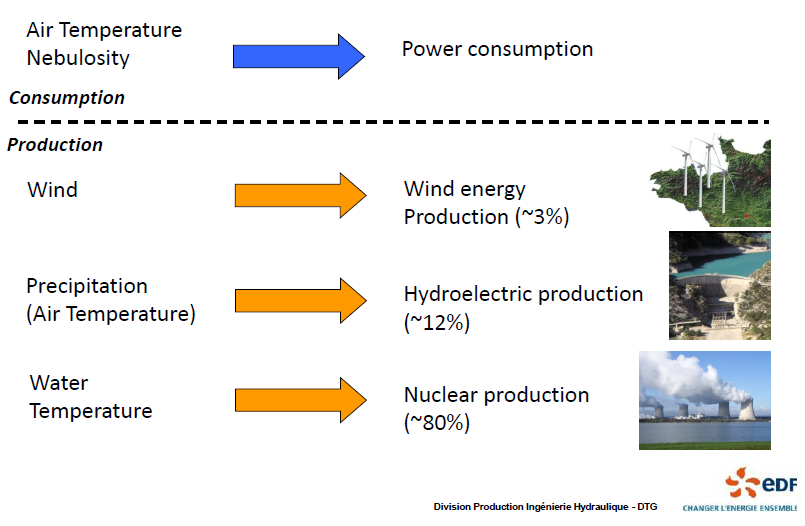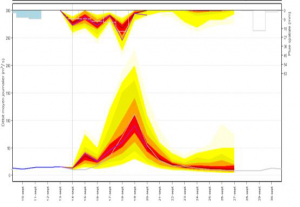Operational Highlight: use of ensemble hydrometeorological forecasts at EDF (French producer of energy)
Contributed by Matthieu Le Lay
As other energy companies, EDF (French producer of energy) is a weather-sensitive company.
 Natural hazards (floods, droughts, storms, heat waves) affect both aspects of energy consumption and production.
Natural hazards (floods, droughts, storms, heat waves) affect both aspects of energy consumption and production.
Hydrometeorological forecasting is consequently an important activity of the group, aiming at improving resources and risk management spatially and at several time scales. Forecasts are necessary to:
- ensure safety and security of installations,
- meet environmental standards,
- improve water resources management,
- optimize the production of power plants.
EDF end-users are dam operators and optimization teams of EDF. In this industrial context, estimation and communication of uncertainties to end-users is of first importance for improving water resources management and decision-making.
 Two forecasting centers (in Grenoble and Toulouse) provide short-term to long-term daily streamflow forecasts for about 130 watersheds (from ~10 to 50000 km²), located mainly in mountainous areas. Meteorological ensemble forecasts are used to forecast rainfall, air temperature and streamflow. Forecasting activities are supported by a hydrometeorological network of about 1200 stations (of which about 700 operate in real-time), operated by EDF and national partners, as well as by Météo-France radar and satellite products.
Two forecasting centers (in Grenoble and Toulouse) provide short-term to long-term daily streamflow forecasts for about 130 watersheds (from ~10 to 50000 km²), located mainly in mountainous areas. Meteorological ensemble forecasts are used to forecast rainfall, air temperature and streamflow. Forecasting activities are supported by a hydrometeorological network of about 1200 stations (of which about 700 operate in real-time), operated by EDF and national partners, as well as by Météo-France radar and satellite products.
Today, numerical weather predictions come from Météo-France deterministic models and ECMWF deterministic and ensemble prediction systems. Statistical analog-based methods are also used to improve the quality of medium-range forecasts (up to 7-15 days in advance).
An expert-based semi-automatic ensemble forecasting chain has been developed to improve forecasters’ estimation and communication of uncertainties. It has been running operationally since December 2010. Currently, it is operated on 50 watersheds and about 6000 forecasts have already been disseminated to 200 end-users. The system was designed to:
- take into account the full range of uncertainties (meteorological and hydrological),
- ensure forecasts with good statistical properties,
- allow human expertise of meteorological and hydrological forecasts.
 Raw ensemble forecasts are post-processed to correct for bias and under-dispersion. Weather forecasts are post-processed using an analog-based approach, while empirical dressing approaches based on empirical distributions of past errors of the rainfall-runoff model are used in the post-processing of streamflow predictions. Forecast quality is evaluated for skill, reliability and sharpness.
Raw ensemble forecasts are post-processed to correct for bias and under-dispersion. Weather forecasts are post-processed using an analog-based approach, while empirical dressing approaches based on empirical distributions of past errors of the rainfall-runoff model are used in the post-processing of streamflow predictions. Forecast quality is evaluated for skill, reliability and sharpness.
Human expertise plays an important role during the whole process: forecasters can modify rainfall, temperature and discharge scenarios according to other information they have available (e.g., high resolution NWP models, radar or satellite monitoring, typical hydrological errors, etc.).
Our experience has showed that:
- communication of uncertainties to end-users is critical,
- estimation of these uncertainties must be objectified to avoid under-dispersion and forecaster’s dependence (complex industrial issues),
- forecasters’ expertise is useful and should be maintained.
The use of ensemble prediction systems allowed us:
- to increase forecast lead-time (it would be unrealistic to achieve 15-days of lead time with a deterministic system),
- to properly quantify and communicate forecast uncertainties,
- to improve water management by using different predicted quantiles according to end-users’ aims and needs.
For more info: see our presentation at the XX SBRH (LeLay et al., 2013; download here) and the following references: Houdant (2004, in French), Garçon et al. (2009, in French), Desaint et al. (2009, in French), Mathevet et al. (2009), Ramos et al. (2010), LeLay et al. (2011), Mathevet et al. (2011), Zalachori et al. (2012), Chardon et al., (2011), Chardon et al. (2012).
0 comments